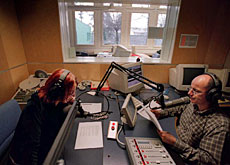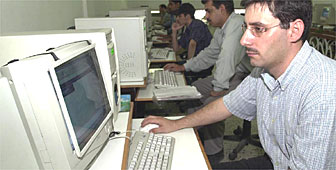Voice of Switzerland prepares to bow out

The “Voice of Switzerland”, which has been broadcasting to listeners around the world for almost 70 years, will fall silent later this month.
The last shortwave transmitter in Switzerland is shutting down, bringing an end to radio broadcasts at swissinfo/Swiss Radio International (SRI).
“For almost 70 years, shortwave has played a fundamental role in making the reality and the aspirations of Switzerland known to the world,” said Nicolas Lombard, the director of SRI.
The Swiss Shortwave Service – as SRI was first known – started broadcasting in 1935.
One of the first shortwave radio stations of its kind, it was aimed at the Swiss living abroad who wanted to keep abreast of news and current affairs back home. Broadcasts in English began six years later in 1941.
“SRI really represented an umbilical cord for our countrymen and women abroad, and for many years they didn’t have any other means of getting information about Switzerland,” said Giovanni Conti, executive director of Swisscom Broadcast, which provided the technical support for shortwave broadcasting.
The rise of fascism in neighbouring countries was another factor that spurred the creation of SRI, whose mandate also included transmitting the country’s national identity and federal principles abroad.
Neutrality
During the Second World War, the station developed its long-standing identity as a neutral voice during periods of international conflict.
But SRI really came to the fore during the Cold War, when shortwave listeners around the world tuned in for unbiased coverage of global events.
By this time, the station was broadcasting in eight languages and was receiving up to 130,000 letters from listeners a year – from all over the world.
“During this period of propaganda, Switzerland’s neutrality certainly helped the success of SRI,” said Lombard, who joined the service in 1965.
It is estimated that SRI had an international audience of between five and ten million people during this time.
New era
In 1972, SRI – prompted by a move towards more powerful transmitting capabilities – inaugurated the Sottens transmitter near Lausanne.
At 500 kilowatts, it was ten times more powerful than its predecessor at Schwarzenburg outside the capital, Bern, which dated from 1938.
But the 1980s saw the beginning of the decline of shortwave. The fall of the Berlin Wall left SRI executives wondering how they could adapt the station’s neutral mandate to a new era of global entente.
Added to this was the advent of new technologies such as FM and satellites, which gradually started to replace shortwave.
During the 1990s, SRI also began the process of transforming itself from shortwave broadcaster to multimedia internet outlet.
But it was the government’s decision to cut funding to SRI that proved the final blow for shortwave radio.
Future
However, Conti sees the passing of radio as a transition rather than the end of an era.
“If one shuts off an old technology like shortwave, another one comes in its place like digital,” he said.
“We must maintain a qualitative level of old technologies as long as possible, without, however, missing the boat on the new ones,” added Corti.
Lombard agrees that new technology is the way forward.
“The internet cannot replace what was on offer on shortwave,” he said. “But it offers new and great possibilities for multimedia communication, which until now one couldn’t possibly imagine.”
swissinfo, Armando Mombelli
1935: Swiss Shortwave Service created.
1939: First shortwave transmitter for the service at Schwarzenburg.
1972: Sottens transmitter opened.
1978: Service renamed Swiss Radio International.
2004: Sottens transmitter closes, ending shortwave era.
With radio programmes in eight languages, SRI reached an estimated five to ten million listeners worldwide during the Cold War.
By the end of the 1990s, shortwave was in decline and SRI decided to abandon shortwave radio broadcasting.
swissinfo/SRI now concentrates exclusively on its multimedia website, www.swissinfo.org.

In compliance with the JTI standards
More: SWI swissinfo.ch certified by the Journalism Trust Initiative





You can find an overview of ongoing debates with our journalists here. Please join us!
If you want to start a conversation about a topic raised in this article or want to report factual errors, email us at english@swissinfo.ch.